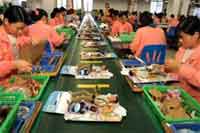| |
|
| |
|
 |
Supply
Chain by the Numbers |
| |
|
| |
- January 12, 2017 -
|
| |
|
| |
|
| |
|
| |
Bringing Toy Producton Back to US a Tough Order; Alibaba CEO Says Tons of US Jobs Coming; Procurement Improvements Driver Major Profit Gains; Right to Work States Gain New Member |
| |
|
| |
| |
| |
$10 |

|
|
|
| |
| |
|
15%
|
|
That’s the amount that total company profits on average increase if its procurement organization can move from the bottom quartile of performance to the middle of the pack. That according to the just released Return on Supply Management Assets or ROSMA report from the consultants at AT Kearney, the Institute for Supply Management and the Chartered Institute of Procurement & Supply or CIPS – basically the ISM of Europe. Companies moving from mid-level performance to the top quartile can do even better, averaging a 21% gain in earnings from the move, the research finds. It adds that currently, private equity firms are looking first to procurement versus anything else as a source of savings in mergers and acquisitions. Is procurement where the supply chain money really is?
|
| |
| |
|
| |
| |
27 |
|
That’s how many so-called right to work states there currently are in the US after Kentucky’s now all Republican legislature and governor fulfilled a campaign promise and quickly pushed through the measure upon taking office the first week of January. Of course, in right to work states company employees cannot be required to join a union that is in place at the firm. Kentucky Governor Bevin noted that the state had lost manufacturing plant opportunities such as a Volvo factory that went to South Carolina and "because we were not a right-to-work state we didn’t make the final cut." With the change, all of what are generally considered the Southern states now have right to work provisions. The other big bock of right to work states are in the West, but in the past few years the Midwestern states of Indiana, Wisconsin and Michigan have also adopted the rule, so that right to work states now constitute a majority. Missouri and New Hampshire may be next following the election of new GOP Governors, each with hearings scheduled soon on right to work.
|
| |
| |
|
|
|
| |
 |
 |
| |
|
|
| |